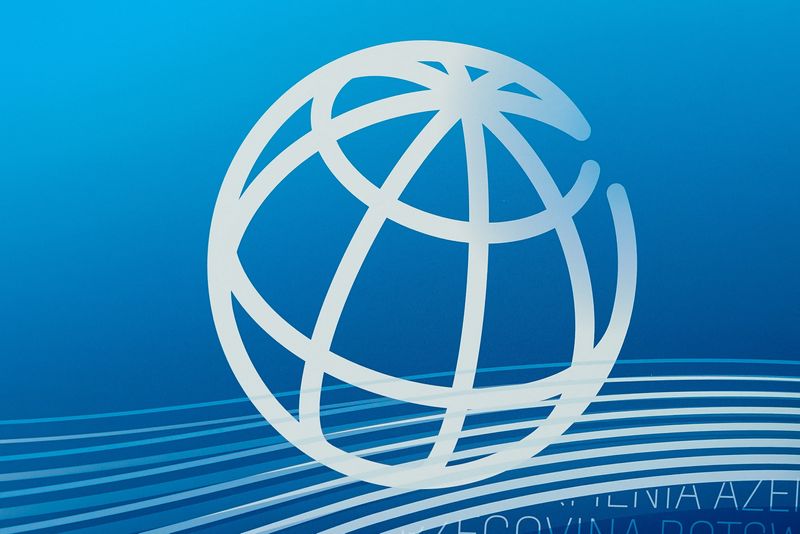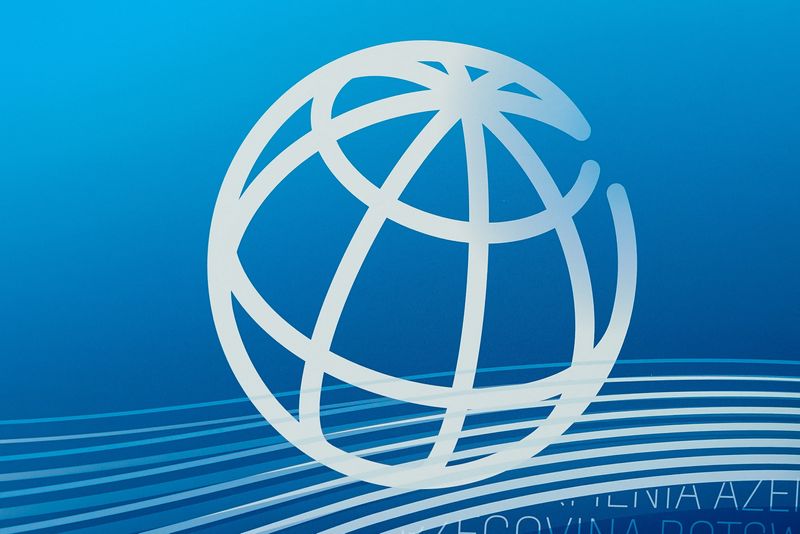Economy
Developing countries spent record $443.5 billion to service public debts in 2022- World Bank


© Reuters. FILE PHOTO: The World Bank logo is seen at the 2023 Spring Meetings of the World Bank Group and the International Monetary Fund in Washington, U.S., April 13, 2023. REUTERS/Elizabeth Frantz/File Photo
By Andrea Shalal
WASHINGTON (Reuters) – Developing countries spent nearly half a trillion dollars to service their external public and publicly guaranteed debt in 2022, draining funds from critical health, education and climate needs, and putting the poorest countries at increasing risk of “tumbling into a debt crisis,” the World Bank said on Wednesday.
In its latest International Debt Report, the bank said the debt-service payments – including principal and interest – rose 5% to a record $443.5 billion from a year earlier amid the biggest surge in global interest rates in four decades. It said the payments could shoot 10% higher in 2023-2024.
The 75 poorest countries were hardest hit, said the report, now in its 50th year. Their external public debt service payments reached a record $88.9 billion in 2022 and would surge by 40% over the 2023-2024 period. Their interest payments alone had quadrupled since 2012 to $23.6 billion, it said.
“This is the decade of reckoning,” World Bank chief economist Indermit Gill told Reuters in an interview. “Record debt levels and high interest rates have set many countries on a path to crisis,” he said, warning that continued high interest rates would push more developing countries into debt distress.
Gill said he was paying close attention to Ethiopia’s discussions with bondholders after a breakdown in talks over how long to extend the maturity and spread out repayments of its single $1 billion international bond maturing in December 2024.
“Ethiopia is like a canary in the coal mine,” he said. “It’s the biggest country that would default. That’s an important one. It’s one of the five biggest economies in sub-Saharan Africa.”
Ethiopia is careening toward default after it said last week it could not pay a $33 million bond coupon due on Monday.
Gill told reporters that steep debt servicing costs, high debt burdens and slowing growth in many countries raised concerns about a new debt crisis and the risk of contagion, but said he does not view that risk as “imminent.”
He said the situation would remain difficult for developing countries, with past experience indicating that interest rates were unlikely to come down “anytime soon” especially since supply shocks could jack up inflation again quickly.
Gill called for “quick and coordinated action” by debtor countries, private and official creditors, and multilateral financial institutions to improve transparency, develop better debt sustainability tools, and speed up debt restructurings.
African countries faced “another lost decade,” Gill told Reuters, noting they had seen no per capita income growth since 2014 on average.
The report said one in every four developing countries was now priced out of international capital markets and there had been 18 sovereign debt defaults in 10 countries over the past three years, more than in the past two decades combined.
Debt service payments consumed an ever-larger share of export revenues, with some countries now “just one shock away from a debt crisis,” Gill wrote in the report, noting that about 60% of low-income countries already in or at risk of debt distress. Domestic debt levels were also high in countries like Argentina and Pakistan, increasing risks.
Countries that deferred making principal and interest payments under the Group of 20’s Debt Service Suspension Initiative (DSSI) adopted during the COVID pandemic also faced additional costs now that those payments were due, the bank said, although exact data won’t be reported until 2024.
The report noted private capital had largely withdrawn from developing countries, favoring higher interest rates in advanced economies. Private creditors received $185 million more in principal repayments than they disbursed in loans, the first time that was seen since 2015. Overall, there was a net outflow of $127.1 billion from low- and middle-income countries to bondholders, compared to an average inflow of $202 billion from 2019-2021.
The World Bank and other multilateral creditors, helped fill the gap, providing a record $115 billion in new financing for developing countries in 2022, the report said.
Economy
Russian central bank says it needs months to make sure CPI falling before rate cuts -RBC


© Reuters. Russian Central Bank Governor Elvira Nabiullina attends a news conference in Moscow, Russia June 14, 2019. REUTERS/Shamil Zhumatov/File Photo
MOSCOW (Reuters) – Russia’s central bank will need two to three months to make sure that inflation is steadily declining before taking any decision on interest rate cuts, the bank’s governor Elvira Nabiullina told RBC media on Sunday.
The central bank raised its key interest rate by 100 basis points to 16% earlier in December, hiking for the fifth consecutive meeting in response to stubborn inflation, and suggested that its tightening cycle was nearly over.
Nabiullina said it was not yet clear when exactly the regulator would start cutting rates, however.
“We really need to make sure that inflation is steadily decreasing, that these are not one-off factors that can affect the rate of price growth in a particular month,” she said.
Nabiullina said the bank was taking into account a wide range of indicators but primarily those that “characterize the stability of inflation”.
“This will take two or three months or more – it depends on how much the wide range of indicators that characterize sustainable inflation declines,” she said.
The bank will next convene to set its benchmark rate on Feb. 16.
The governor also said the bank should have started monetary policy tightening earlier than in July, when it embarked on the rate-hiking cycle.
Economy
China identifies second set of projects in $140 billion spending plan


© Reuters. FILE PHOTO: Workers walk past an under-construction area with completed office towers in the background, in Shenzhen’s Qianhai new district, Guangdong province, China August 25, 2023. REUTERS/David Kirton/File Photo
SHANGHAI (Reuters) – China’s top planning body said on Saturday it had identified a second batch of public investment projects, including flood control and disaster relief programmes, under a bond issuance and investment plan announced in October to boost the economy.
With the latest tranche, China has now earmarked more than 800 billion yuan of its 1 trillion yuan ($140 billion) in additional government bond issuance in the fourth quarter, as it focuses on fiscal steps to shore up the flagging economy.
The National Development and Reform Commission (NDRC) said in a statement on Saturday it had identified 9,600 projects with planned investment of more than 560 billion yuan.
China’s economy, the world’s second largest, is struggling to regain its footing post-COVID-19 as policymakers grapple with tepid consumer demand, weak exports, falling foreign investment and a deepening real estate crisis.
The 1 trillion yuan in additional bond issuance will widen China’s 2023 budget deficit ratio to around 3.8 percent from 3 percent, the state-run Xinhua news agency has said.
“Construction of the projects will improve China’s flood control system, emergency response mechanism and disaster relief capabilities, and better protect people’s lives and property, so it is very significant,” the NDRC said.
The agency said it will coordinate with other government bodies to make sure that funds are allocated speedily for investment and that high standards of quality are maintained in project construction.
($1 = 7.1315 renminbi)
Economy
Russian central bank says it needs months to make sure CPI falling before rate cuts -RBC


© Reuters. Russian Central Bank Governor Elvira Nabiullina attends a news conference in Moscow, Russia June 14, 2019. REUTERS/Shamil Zhumatov/File Photo
MOSCOW (Reuters) – Russia’s central bank will need two to three months to make sure that inflation is steadily declining before taking any decision on interest rate cuts, the bank’s governor Elvira Nabiullina told RBC media on Sunday.
The central bank raised its key interest rate by 100 basis points to 16% earlier in December, hiking for the fifth consecutive meeting in response to stubborn inflation, and suggested that its tightening cycle was nearly over.
Nabiullina said it was not yet clear when exactly the regulator would start cutting rates, however.
“We really need to make sure that inflation is steadily decreasing, that these are not one-off factors that can affect the rate of price growth in a particular month,” she said.
Nabiullina said the bank was taking into account a wide range of indicators but primarily those that “characterize the stability of inflation”.
“This will take two or three months or more – it depends on how much the wide range of indicators that characterize sustainable inflation declines,” she said.
The bank will next convene to set its benchmark rate on Feb. 16.
The governor also said the bank should have started monetary policy tightening earlier than in July, when it embarked on the rate-hiking cycle.

 Forex3 years ago
Forex3 years agoForex Today: the dollar is gaining strength amid gloomy sentiment at the start of the Fed’s week

 Forex3 years ago
Forex3 years agoUnbiased review of Pocket Option broker

 Forex3 years ago
Forex3 years agoDollar to pound sterling exchange rate today: Pound plummeted to its lowest since 1985

 Forex3 years ago
Forex3 years agoHow is the Australian dollar doing today?

 Cryptocurrency3 years ago
Cryptocurrency3 years agoWhat happened in the crypto market – current events today

 World3 years ago
World3 years agoWhy are modern video games an art form?

 Commodities3 years ago
Commodities3 years agoCopper continues to fall in price on expectations of lower demand in China

 Economy3 years ago
Economy3 years agoCrude oil tankers double in price due to EU anti-Russian sanctions



























